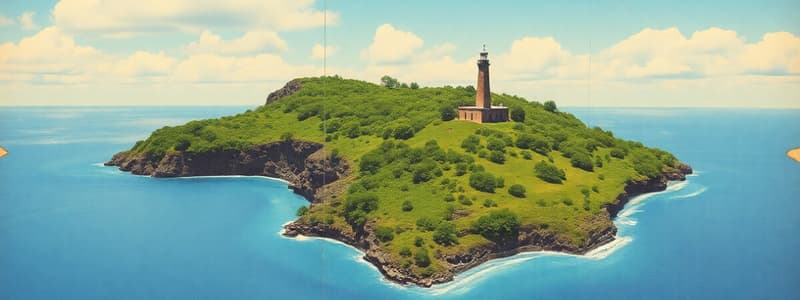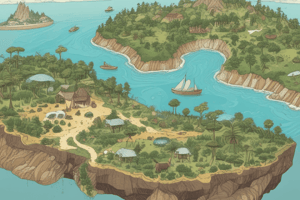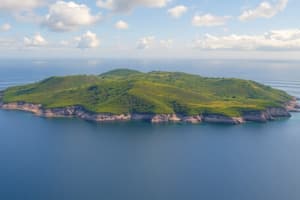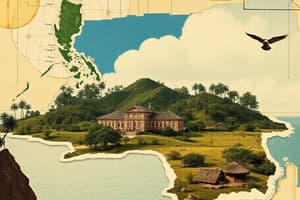Podcast
Questions and Answers
How does island size typically correlate with species richness?
How does island size typically correlate with species richness?
- Larger islands generally support greater species richness. (correct)
- Species richness is solely determined by the proximity of the island to the mainland.
- Smaller islands tend to have higher species richness due to decreased competition.
- Island size and species richness are not correlated.
What is the focus of geographic ecology as defined by MacArthur?
What is the focus of geographic ecology as defined by MacArthur?
- Detailed studies of individual species' behaviors.
- The search for patterns of plant and animal life that can be mapped. (correct)
- The impact of climate change on local ecosystems.
- Analysis of genetic variations within isolated populations.
Which factor, according to Nilsson et al.'s study in Sweden, was the best predictor of species richness?
Which factor, according to Nilsson et al.'s study in Sweden, was the best predictor of species richness?
- Island area. (correct)
- Mean annual temperature.
- Distance to the mainland.
- Vegetation type.
Following the Pleistocene epoch, how did climate warming affect forest and alpine habitats in the American Southwest?
Following the Pleistocene epoch, how did climate warming affect forest and alpine habitats in the American Southwest?
Why are mountain tops sometimes referred to as 'habitat islands'?
Why are mountain tops sometimes referred to as 'habitat islands'?
Arrhenius is recognized in geographic ecology for what contribution?
Arrhenius is recognized in geographic ecology for what contribution?
What distinguishes geographic ecology from other ecological studies?
What distinguishes geographic ecology from other ecological studies?
Which of the following best describes a focus of geographic ecology?
Which of the following best describes a focus of geographic ecology?
Simberloff's experiment on mangrove islands primarily demonstrated what relationship between island area and species richness?
Simberloff's experiment on mangrove islands primarily demonstrated what relationship between island area and species richness?
Which of the following statements accurately reflects the relationship between island size and species accumulation?
Which of the following statements accurately reflects the relationship between island size and species accumulation?
What is a primary challenge in determining the effects of island area on species richness?
What is a primary challenge in determining the effects of island area on species richness?
According to the latitudinal gradient hypothesis, where is species richness generally highest?
According to the latitudinal gradient hypothesis, where is species richness generally highest?
Which of Brown's (1988) hypotheses suggests that the tropics have more species due to a longer period of stability and less frequent disturbances?
Which of Brown's (1988) hypotheses suggests that the tropics have more species due to a longer period of stability and less frequent disturbances?
What is the central idea behind the productivity hypothesis in explaining latitudinal gradients in species richness?
What is the central idea behind the productivity hypothesis in explaining latitudinal gradients in species richness?
Connell (1978) proposed an alternative perspective on tropical diversity, suggesting it is primarily maintained by what factor?
Connell (1978) proposed an alternative perspective on tropical diversity, suggesting it is primarily maintained by what factor?
Assuming the productivity hypothesis is correct, how would increased energy availability most likely affect extinction rates in a given ecosystem?
Assuming the productivity hypothesis is correct, how would increased energy availability most likely affect extinction rates in a given ecosystem?
Which factor, according to Bond and Goldblatt, contributes to the high species richness in the Cape Floristic Region of South Africa?
Which factor, according to Bond and Goldblatt, contributes to the high species richness in the Cape Floristic Region of South Africa?
What is a key reason for the lower tree species richness in European temperate forests compared to those in Eastern Asia and Eastern North America?
What is a key reason for the lower tree species richness in European temperate forests compared to those in Eastern Asia and Eastern North America?
According to the equilibrium model of island biogeography, what primarily determines the rate of immigration to an island?
According to the equilibrium model of island biogeography, what primarily determines the rate of immigration to an island?
Which of the following factors does NOT contribute to an increased rate of extinction as the number of species on an island rises?
Which of the following factors does NOT contribute to an increased rate of extinction as the number of species on an island rises?
How did Rosenzweig's findings contribute to the understanding of species richness in relation to geographical factors?
How did Rosenzweig's findings contribute to the understanding of species richness in relation to geographical factors?
What conclusion can be drawn from the observation that the Cape region of South Africa has more species than the California Floristic Province, despite being smaller?
What conclusion can be drawn from the observation that the Cape region of South Africa has more species than the California Floristic Province, despite being smaller?
In the context of island biogeography, what does 'species turnover' refer to?
In the context of island biogeography, what does 'species turnover' refer to?
According to the information, what was the effect of refuge areas on plant populations in the Cape Floristic Region?
According to the information, what was the effect of refuge areas on plant populations in the Cape Floristic Region?
Based on the equilibrium model, which type of island would be expected to support the lowest number of species?
Based on the equilibrium model, which type of island would be expected to support the lowest number of species?
What was the primary conclusion from Simberloff and Wilson's experiments on the Florida Keys mangrove islands?
What was the primary conclusion from Simberloff and Wilson's experiments on the Florida Keys mangrove islands?
What general trend did Flessa and Brown independently observe regarding continental area and species richness?
What general trend did Flessa and Brown independently observe regarding continental area and species richness?
Latham and Ricklefs (1993) studied temperate zone trees. What disparities did they find when comparing temperate forest biomes in Europe, Eastern Asia, and Eastern North America?
Latham and Ricklefs (1993) studied temperate zone trees. What disparities did they find when comparing temperate forest biomes in Europe, Eastern Asia, and Eastern North America?
According to the equilibrium model of island biogeography, if two islands are the same size but one is closer to the mainland, which island would likely have a higher rate of species turnover?
According to the equilibrium model of island biogeography, if two islands are the same size but one is closer to the mainland, which island would likely have a higher rate of species turnover?
Rydin and Borgegård's research on plant colonization of new islands found a correlation between species richness and which of the following?
Rydin and Borgegård's research on plant colonization of new islands found a correlation between species richness and which of the following?
What did Ralph (1985) discover in Argentina regarding foliage height diversity and bird species diversity?
What did Ralph (1985) discover in Argentina regarding foliage height diversity and bird species diversity?
Imagine two islands of equal size and distance from the mainland. Island A has a more diverse habitat structure than Island B. How would this likely affect the equilibrium number of species on each island?
Imagine two islands of equal size and distance from the mainland. Island A has a more diverse habitat structure than Island B. How would this likely affect the equilibrium number of species on each island?
According to the information, how does environmental heterogeneity influence species diversity in the tropics?
According to the information, how does environmental heterogeneity influence species diversity in the tropics?
Which of the following factors contributes to the 'favorableness' of tropical environments for species diversity?
Which of the following factors contributes to the 'favorableness' of tropical environments for species diversity?
Based on the information, what is a primary distinction between tropical and higher latitude species regarding biological and physical factors?
Based on the information, what is a primary distinction between tropical and higher latitude species regarding biological and physical factors?
How do speciation and extinction rates combine to influence species richness in an area?
How do speciation and extinction rates combine to influence species richness in an area?
According to Terborgh and Rosenzweig, what is the primary reason for greater tropical species richness?
According to Terborgh and Rosenzweig, what is the primary reason for greater tropical species richness?
How does uniform temperature in larger areas contribute to species richness?
How does uniform temperature in larger areas contribute to species richness?
If the tropics have both higher speciation rates and lower extinction rates, what is the expected consequence for species diversity compared to other latitudes?
If the tropics have both higher speciation rates and lower extinction rates, what is the expected consequence for species diversity compared to other latitudes?
How might larger species ranges affect allopatric speciation rates?
How might larger species ranges affect allopatric speciation rates?
Which of the following best describes the relationship between montane island area and montane animal species richness?
Which of the following best describes the relationship between montane island area and montane animal species richness?
According to the studies discussed, how does lake area relate to the number of fish species found within those lakes?
According to the studies discussed, how does lake area relate to the number of fish species found within those lakes?
How do the dispersal abilities of different organisms, such as birds and pteridophytes, influence the relationship between island area and diversity?
How do the dispersal abilities of different organisms, such as birds and pteridophytes, influence the relationship between island area and diversity?
What does the study of montane mammal species on mountaintops in the American Southwest suggest about the role of immigration in maintaining diversity?
What does the study of montane mammal species on mountaintops in the American Southwest suggest about the role of immigration in maintaining diversity?
In the context of island biogeography, what does the equilibrium model propose regarding immigration and extinction rates on a new island?
In the context of island biogeography, what does the equilibrium model propose regarding immigration and extinction rates on a new island?
How does the concept of 'lakes as islands' apply to the study of biogeography?
How does the concept of 'lakes as islands' apply to the study of biogeography?
Considering the role of dispersal abilities in island biogeography, which scenario would likely lead to a weaker relationship between island area and species diversity?
Considering the role of dispersal abilities in island biogeography, which scenario would likely lead to a weaker relationship between island area and species diversity?
MacArthur and Wilson's equilibrium model of island biogeography considers both immigration and extinction rates. How would an increase in the distance of an island from the mainland likely affect these rates, and consequently, the island's species diversity?
MacArthur and Wilson's equilibrium model of island biogeography considers both immigration and extinction rates. How would an increase in the distance of an island from the mainland likely affect these rates, and consequently, the island's species diversity?
Flashcards
Geographic Ecology
Geographic Ecology
The study of ecological structure and process at large geographic scales.
Area and Isolation Effects
Area and Isolation Effects
Species richness increases with area and decreases with isolation.
Geographic Ecology Focus
Geographic Ecology Focus
Species richness patterns on islands, latitudinal gradients, historical influences.
Arrhenius
Arrhenius
Signup and view all the flashcards
Island Area Importance
Island Area Importance
Signup and view all the flashcards
Island Size vs. Bird Species
Island Size vs. Bird Species
Signup and view all the flashcards
Nilsson et al. Findings
Nilsson et al. Findings
Signup and view all the flashcards
Mountain Habitat Shift
Mountain Habitat Shift
Signup and view all the flashcards
Montane Vegetation Fragments
Montane Vegetation Fragments
Signup and view all the flashcards
Lake Area & Species Richness
Lake Area & Species Richness
Signup and view all the flashcards
Island Isolation & Bird Diversity
Island Isolation & Bird Diversity
Signup and view all the flashcards
Island Area & Pteridophyte Diversity
Island Area & Pteridophyte Diversity
Signup and view all the flashcards
Montane Isolation & Mammal Species
Montane Isolation & Mammal Species
Signup and view all the flashcards
Equilibrium Model of Island Biogeography
Equilibrium Model of Island Biogeography
Signup and view all the flashcards
Immigration Rate on Islands
Immigration Rate on Islands
Signup and view all the flashcards
MacArthur and Wilson
MacArthur and Wilson
Signup and view all the flashcards
Island Equilibrium
Island Equilibrium
Signup and view all the flashcards
Extinction Factors
Extinction Factors
Signup and view all the flashcards
Species Number Prediction
Species Number Prediction
Signup and view all the flashcards
Immigration Rate Factor
Immigration Rate Factor
Signup and view all the flashcards
Extinction Rate Factor
Extinction Rate Factor
Signup and view all the flashcards
Species Turnover
Species Turnover
Signup and view all the flashcards
Island Recolonization
Island Recolonization
Signup and view all the flashcards
Area and Richness
Area and Richness
Signup and view all the flashcards
Island Size & Species Richness
Island Size & Species Richness
Signup and view all the flashcards
Impact of Reducing Island Area
Impact of Reducing Island Area
Signup and view all the flashcards
Latitudinal Gradient in Species Richness
Latitudinal Gradient in Species Richness
Signup and view all the flashcards
Time Since Perturbation Hypothesis
Time Since Perturbation Hypothesis
Signup and view all the flashcards
Productivity Hypothesis
Productivity Hypothesis
Signup and view all the flashcards
Habitat Diversity and Area Effects
Habitat Diversity and Area Effects
Signup and view all the flashcards
Simberloff's Mangrove Island Experiment
Simberloff's Mangrove Island Experiment
Signup and view all the flashcards
Tropics and Species Richness
Tropics and Species Richness
Signup and view all the flashcards
Environmental Heterogeneity
Environmental Heterogeneity
Signup and view all the flashcards
Tropics' Species Richness
Tropics' Species Richness
Signup and view all the flashcards
Niche Subdivision
Niche Subdivision
Signup and view all the flashcards
Favorableness Hypothesis
Favorableness Hypothesis
Signup and view all the flashcards
Biotic vs. Abiotic Limits
Biotic vs. Abiotic Limits
Signup and view all the flashcards
Speciation Rate
Speciation Rate
Signup and view all the flashcards
Extinction Rate
Extinction Rate
Signup and view all the flashcards
Area and Species Richness
Area and Species Richness
Signup and view all the flashcards
Continental Area vs. Species
Continental Area vs. Species
Signup and view all the flashcards
Historical/Regional Influence
Historical/Regional Influence
Signup and view all the flashcards
Cape Floristic Region
Cape Floristic Region
Signup and view all the flashcards
Cape Richness Factors
Cape Richness Factors
Signup and view all the flashcards
Temperate Forest Diversity
Temperate Forest Diversity
Signup and view all the flashcards
European Mountains' Impact
European Mountains' Impact
Signup and view all the flashcards
Extinction Rate in Europe
Extinction Rate in Europe
Signup and view all the flashcards
Foliage vs Bird Diversity
Foliage vs Bird Diversity
Signup and view all the flashcards
Study Notes
- Geographic ecology is the search for patterns of plant and animal life that can be put on a map.
- Geographic ecology studies ecological structure and processes at large geographic scales.
Area, Isolation, and Species Richness
- Arrhenius developed a quantitative relationship between area and the number of species, pioneering geographic ecology.
- He worked on islands in Sweden, but at scales smaller than the geographic scale.
- Preston researched the relationship between species number and island area in the West Indies and found the fewest bird species live on the smallest islands, while most species live on the largest islands.
- Nilsson et al. determined that island area in Sweden was the best single predictor of species richness for woody plants, carabid beetles, and land snails.
- Climate warming at the end of the Pleistocene caused forest and alpine habitats to contract to the tops of high mountains across the American Southwest, resulting in island-like fragments, also known as montane vegetation.
- Montane animal distributions contracted, and species richness correlated with montane island area.
- Lakes can be considered habitat islands, with varying degrees of isolation.
- Tonn and Magnuson studied Wisconsin lakes and discovered the number of species increases with the area of the lake.
- Barbour and Brown studied 70 lakes globally and found a positive relationship between area and fish species richness.
- MacArthur and Wilson found that isolation reduces bird diversity on Pacific Islands.
- Williamson studied island area and species richness on the Azore and Channel Islands.
- Birds and pteridophytes show increased diversity with increasing island area.
- Bird diversity is influenced by isolation, unlike pteridophyte diversity, which reflects differences in dispersal abilities (pteridophytes produce light spores).
- Lomolino et al. studied montane mammal species on mountaintops across the American Southwest and found a negative correlation between isolation and species number, suggesting immigration's importance in maintaining diversity.
Equilibrium Model of Island Biogeography
- MacArthur and Wilson explained species diversity patterns on islands as a result of the equilibrium between immigration and extinction rates, known as the equilibrium model of island biogeography.
- Immigration rates are highest on new islands with no organisms, and decline as species accumulate because fewer arrivals constitute new species.
- Extinction rates rise with increasing numbers of species because there is a larger pool of potential extinctions, population size of each species diminishes, and competition between species increases.
- The number of species that will occur on an island is predicted by the point where immigration and extinction lines cross.
- The rate of immigration is mainly determined by distance from the source of immigrants, while the rate of extinction is mainly determined by island size.
- Large near islands support the highest number of species, while small far islands support the lowest number and small near and large far islands support intermediate numbers.
- The equilibrium model suggests that species composition on islands is dynamic.
- Changes in species composition are referred to as species turnover.
- Diamond found birds on nine Channel Islands in a stable equilibrium, due to approximately equal numbers of immigrations and extinctions, i.e. species turnover occurred.
- Simberloff and Wilson studied insect recolonization in Florida Keys and after one year, defaunated islands nearly returned to original species numbers, though the species composition changed.
- Rydin and Borgegård found that variation in species richness was positively correlated with island area, explaining 44 to 85% of species richness variation among islands.
- Small and medium islands continued to accumulate species, while large islands reached equilibrium and it is difficult to separate the effects of habitat diversity from area effects.
- Simberloff tested the effect of island area on species richness in mangrove islands.
- In all cases where the area was reduced, species richness decreased, whereas richness on control islands increased slightly, indicating that area has a positive influence on species richness.
Latitudinal Gradients in Species Richness
- Species richness generally increases from middle and high latitudes towards the equator.
- The pattern of increased number of species in the tropics is pervasive and dramatic which forms the basis for latitudinal gradient hypotheses.
- Brown (1988) grouped the hypotheses into six categories.
- Tropics have more species because they are older and disturbed less frequently, allowing more time for speciation and reducing the extinction rate.
- Additionally, there are assumptions the tropics have remained relatively stable, whilst middle and high latitudes have been disrupted by glaciation.
- Conversely, Connell (1978) proposed that tropical diversity is maintained by disturbance.
- High productivity contributes to high species richness, leading to more energy, more specialized consumers with larger populations, lower chance of extinction, and extinction rates.
- Tropics have more species because they are more heterogeneous, though most tropical species occur in fewer environments than high latitude species.
- Species in more diverse communities tend to subdivide the environment more finely.
- Tropics provide more favorable environments, while high latitude environments have more temperature variation and physically extreme environments restrict diversity.
- Several hypotheses concern relative niche breadths and interspecific interactions, such as tropical species being limited more by biological factors than physical factors and subject to controls by predators, pathogens, and parasites.
- Rosenzweig proposed immigration can be discounted at large scales, emphasizing the differences in speciation and extinction rates.
- The number of species in an area reflects the rate at which new species have been added minus the rate at which they have disappeared.
Historical and Regional Influences
- Long-term historical and regional processes can significantly influence species richness and diversity.
- There are differences in species richness that cannot be explained by area, such as the Cape region of South Africa, which is smaller than the California Floristic Province, yet has more species.
- Bond and Goldblatt attributed the Cape Floristic Region's unusually high species richness to continental drift, a wide variety of soil types, repeated expansion, contraction, and isolation of plant populations, and refuge areas reducing extinction rates.
- Latham and Ricklefs (1993) studied temperate zone trees and found that temperate forest biomes in Europe, Eastern Asia, and Eastern North America all have roughly equal area, but vastly different levels of biological diversity.
- Ralph (1985) found a negative correlation between foliage height diversity and bird species diversity in Argentina.
- Mountains in Europe form east-west oriented barriers, where during the the last ice age, temperate trees had their southward retreat largely cut-off, resulting in lower species richness as a consequence of a higher extinction rate.
- The Appalachian Mountains in North America run north-south, providing temperate trees an avenue of retreat as temperatures became colder.
- There were no mountain barriers in Asia, leading to the conclusion that most temperate tree taxa originated in Eastern Asia and dispersed to Europe and North America.
- After dispersal routes were cut, speciation continued in Asia.
Studying That Suits You
Use AI to generate personalized quizzes and flashcards to suit your learning preferences.




